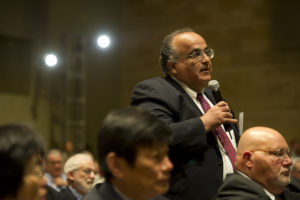7.4: Audience Participation
- Page ID
- 46196
Learning Outcomes
- Discuss effective ways to use audience participation
- Discuss appropriate ways to respond to questions without derailing a presentation
Audience participation is not only an effective way to reinforce learning, it’s associated with higher levels of attendee engagement, which may translate into higher satisfaction and understanding. Consider the following audience participation options, drawn from The Toastmasters International Guide to Successful Speaking and other sources:
- Volunteer Exercise: Invite a member of the audience to participate in an exercise or role-play.
- Audience Survey: Surveying the audience—for example, “by show of hands”—allows you to assess the needs and temperament of the audience and fine-tune your speech accordingly.
- Question: Asking a leading question of the audience like, “What is your biggest hurdle when preparing for employee performance reviews?” allows a speaker to surface ideas or problems and challenges to be addressed during the speech.
- Q&A: A variation on the question technique, time for a Q&A period at the end of the speech allows attendees to clarify open points. Make sure you anticipate likely questions and are prepared with answers. Thorough audience analysis (as discussed in previous modules) will help you anticipate both the content and the level of sophistication of the questions you might get. To overcome initial audience reluctance, you can plant questions, prompt with frequently asked questions, or draw from questions submitted in a pre-session survey.
- Partner Exercise: Pair audience members to practice a technique learned or test learning with a think-pair-share or other collaborative learning exercise.
- Small Group Exercise: Best used for brainstorming solutions or to generate relevant questions for deeper learning or more specific application.
- Written exercises or note-taking: Asking attendees to take notes or complete written exercises—answering a self-assessment, identifying goals, taking a quiz, or filling out a worksheet.
You may notice that these techniques are all pretty straightforward. You should avoid using audience participation plans that are too off-the-wall—like asking your audience to sing, to mime their morning routine, or to hug the person next to them (all real examples). Such techniques are as likely to alienate your audience and lessen your credibility as they are to enhance your speech.
Responding to Questions

A key consideration when incorporating audience participation is maintaining control. To avoid having an exercise deteriorate into chaos or a question turn into an an extended digression, set clear expectations and enforce the ground rules. If you ask participants to do a partner or small group exercise, clearly communicate the process and timeframe. Let participants know how long an exercise will last and tell them when to begin and when to stop. Allow enough time for participants to get value from the exercise but not so much time that some groups become bored or distracted.
The University of Leicester’s oral presentation student resources provide preparation perspective and the following 4 step approach to managing Q&A:[1]
- Listen: Don’t jump to conclusions and start framing a response before the attendee finishes stating the question. Knowing that the questioner is likely thinking on his or her feet, consider both the content and intent of the question.
- Understand: Paraphrase the question to confirm understanding.
- Communicate & Involve: To involve the entire audience and minimize the risk of an extended dialogue with the questioner, restate the question so all can hear and feel a part of the conversation.
- Respond: Direct your answer to both the questioner and other audience members. Keep your response focused and confirm that you answered the question.
Their planning notes are worth considering as Q&A guidelines. For example, you may decide to limit the topics open for discussion or defer questions that are outside the scope of your talk. You might open a Q&A with a limiting phrase such as, “Are there any questions on the four techniques I’ve presented?” Or you could “table” a question with a response indicating that the question falls outside of the stated purpose for your speech and an softening statement such as, “I’d love discuss that with you at another time, feel free to email me.” As with audience participation during the speech, it may be worth establishing and communicating a time limit for individual questions and the overall Q&A session.
Practice Question
- Audience Participation. Authored by: Nina Burokas. Provided by: Lumen Learning. License: CC BY: Attribution
- Questioning the Secretary of Energy. Provided by: energy.gov. Located at: https://commons.wikimedia.org/wiki/File:SunShot_Q%26A_(7374776540).jpg. License: Public Domain: No Known Copyright

